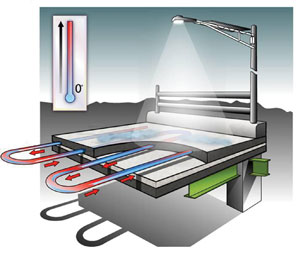In January, we reported on the Solar Roadways project (“Pushing the envelope: Trends in green research and technology,” p. 45), which is working toward using road surfaces as giant electricity generators. But here is another solar-on-the-road project that uses solar to warm roads while sending electricity back to the grid.
Developed by Corey McDonald, founder, president and CEO of Pave Guard Technologies Inc. in Lee’s Summit, Mo., the system uses traditional silicon photovoltaic (PV) cells to warm the surfaces of bridges, thus preventing icing. It works much like radiant heating in a floor but uses the sun to heat a glycose liquid and to power a pump that pushes the liquid through pipes embedded under the road. Sensors activate the system when the temperature drops to 40 °F. The rest of the time, the solar arrays are busily generating electricity and sending it back to the grid.

A system developed by Pave Guard Technologies Inc. warms the road with a liquid pumped beneath the surface and heated by the sun.
In testing, McDonald calculated the amount of space to be heated and the energy that would be used, then determined what the payback would be. “You only need to thaw roads for maybe five or six weeks out of the year,” he said, “which allows payback during the other months.”
The Missouri Department of Transportation plans to install the system this year on two bridges in need of upgrading and to repair or replace more than 800 bridges by the winter of 2013. So, if the system holds up to the initial test, it could become more widespread.
McDonald said other advantages to the PV system include lighting, remote monitoring and preventive maintenance. The PV panels have great potential for powering LED lighting on bridges and highways, he noted, adding that many LED highway lighting projects are working very well with solar.
And because the PV system includes monitoring sensors, the transportation department can skip the step of pretreating road surfaces and can monitor conditions remotely.
In terms of preventive maintenance, keeping road surfaces from freezing extends the life of the pavement. Ultimately, however, the greatest advantage is safety, which has the potential for unlimited payback.